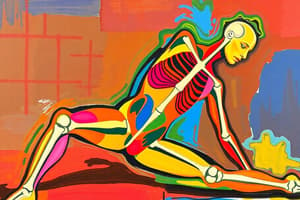Podcast
Questions and Answers
What does osteokinematics primarily describe?
What does osteokinematics primarily describe?
- Motion that is only rotary in nature
- Motion of ligaments around joints
- Motion of bones in a straight line only
- Motion of bones in the three cardinal planes (correct)
Which plane is associated with flexion and extension movements?
Which plane is associated with flexion and extension movements?
- Sagittal plane (correct)
- Horizontal plane
- Frontal plane
- Transverse plane
How is the axis of rotation described in biomechanical terms?
How is the axis of rotation described in biomechanical terms?
- As a series of angular displacements only
- As a symmetrical axis related to the body's weight
- Based on the corresponding plane of motion (correct)
- As a linear motion without direction
In the anatomical position, which finger is used as the reference point for abduction and adduction of the fingers?
In the anatomical position, which finger is used as the reference point for abduction and adduction of the fingers?
Which of these terms describes a type of motion that occurs around an axis?
Which of these terms describes a type of motion that occurs around an axis?
What kind of motion occurs around an axis of rotation and can be measured in degrees?
What kind of motion occurs around an axis of rotation and can be measured in degrees?
Which of the following best describes curvilinear motion?
Which of the following best describes curvilinear motion?
What is the maximum number of degrees of freedom for human joints based on the planes of movement?
What is the maximum number of degrees of freedom for human joints based on the planes of movement?
How many degrees of freedom does the elbow joint have?
How many degrees of freedom does the elbow joint have?
Which joints are involved in both flexion and rotation movements in the human body?
Which joints are involved in both flexion and rotation movements in the human body?
What is the motion called when the toes move toward the big toe?
What is the motion called when the toes move toward the big toe?
Which term describes the wrist movement toward the midline in the anatomical position?
Which term describes the wrist movement toward the midline in the anatomical position?
What type of motion occurs in the transverse plane involving the shoulder when moving toward the midline?
What type of motion occurs in the transverse plane involving the shoulder when moving toward the midline?
In which axis does wrist ulnar and radial deviation occur?
In which axis does wrist ulnar and radial deviation occur?
What are the two degrees of freedom at the wrist?
What are the two degrees of freedom at the wrist?
What differentiates active motion from passive motion?
What differentiates active motion from passive motion?
Which type of end-feel occurs when motion is stopped by ligaments or the joint capsule?
Which type of end-feel occurs when motion is stopped by ligaments or the joint capsule?
What tool is primarily used by physical therapists to quantify osteokinematic motion?
What tool is primarily used by physical therapists to quantify osteokinematic motion?
What does hard end-feel indicate when assessing joint motion?
What does hard end-feel indicate when assessing joint motion?
Flashcards are hidden until you start studying
Study Notes
Introduction to Biomechanics
- Lecture focuses on biomechanics, particularly osteokinematics.
- Objectives include defining osteokinematics, differentiating linear motion from rotary motion, and understanding degrees of freedom in joints.
Osteokinematics Overview
- Osteokinematics refers to bone motion in three planes: sagittal, frontal, and horizontal.
- Movements are around axes: anterior-posterior, medial-lateral, and vertical.
- Common terms: abduction, adduction, flexion, extension, and rotation.
Anatomical Position
- Anatomical position is the standard reference for describing motion.
- For fingers, reference for movement is the middle finger; for toes, the big toe.
Motion Types and Exceptions
- Abduction and adduction differ by body part: fingers use the middle finger, toes use the big toe.
- Horizontal abduction/adduction occurs in the transverse plane, typically at the shoulder.
- Wrist deviations referred to as ulnar and radial deviations instead of abduction/adduction.
- Ankle movements include inversion (toward midline) and eversion (away from midline).
Motion in the Forearm
- Pronating and supinating involves the radius rotating over the stationary ulna.
- Thumb opposition involves a combination of movements (flexion and adduction) and can perform circumduction.
Curvilinear Motion
- Curvilinear motion includes a combination of rotary and linear motions, seen in behaviors like mouth opening and complex joint movements.
- Early phase of mouth opening involves rotation; the later phase includes more translation.
Degrees of Freedom
- Degrees of freedom indicate the number of movement planes available to a joint, with a maximum of three planes for any joint.
- Glenohumeral joint of the shoulder has three degrees of freedom: flexion/extension (sagittal), abduction/adduction (frontal), and rotation (horizontal).
- Elbow has two degrees of freedom: flexion/extension (humeroulnar) and pronation/supination (humeroradial).
- Wrist also has two degrees of freedom: flexion/extension and ulnar/radial deviation.
Clinical Applications of Osteokinematics
- Goniometry quantifies osteokinematic motion, assessing both active (muscle-driven) and passive (externally driven) movements.
- Familiarity with goniometers is expected in clinical settings.
End-Feel Types
- End-feel assessments identify normal and pathological joint resistance during motion.
- Three primary end-feel types:
- Hard (bony) end-feel occurs when motion ceases due to bone contact.
- Firm (capsular) end-feel results from ligament or joint capsule restrictions.
- Soft end-feel describes compression of soft tissues.
- Pathological end-feel indicates abnormal resistance due to joint impairment.
Practical Application
- Goniometers measure joint motion accurately in clinical practice.
- Expect hands-on practice with these tools in future coursework.### Clinical Application of End-Feel
- End-feel is essential for therapists to assess joint resistance and identify impairments.
- Three main types of end-feel: hard (bony), firm (capsular), and soft.
- Hard end-feel occurs when motion is stopped by bone, e.g., elbow extension by the olecranon process fitting into the fossa of the humerus.
- Firm end-feel happens when motion is resisted by ligaments or the joint capsule, e.g., wrist flexion feeling springy due to ligaments crossing the dorsal aspect.
- Soft end-feel results from approximation of soft tissues, usually muscle, e.g., elbow flexion restricted by muscular tissue in a muscular individual.
- Pathologic end-feel indicates abnormal joint limitations, e.g., bony end-feel during knee flexion, which should normally feel soft.
- Empty end-feel signifies pain preventing joint motion, often caused by injury or inflammation.
Kinematic Chain in Body Movement
- The body functions as a single kinematic chain where movement in one part affects movement in others.
- Evaluation of pain should extend beyond the affected area to connected segments (e.g., low back pain may involve hip, knee, or ankle).
- Movement is described as either open kinematic chain (distal segment not fixed) or closed kinematic chain (distal segment fixed).
- In open kinematic chain, e.g., knee flexion while seated, the foot is free to move; in closed kinematic chain, e.g., squatting, the foot remains fixed.
Arthrokinematics vs. Osteokinematics
- Arthrokinematics examines motion between joint surfaces, while osteokinematics focuses on bone movement.
- Common arthrokinematic motions include rolling, sliding (gliding), and spinning, with combinations often occurring during joint movement.
- Rolling involves multiple points on one surface contacting multiple points on another, e.g., shoulder abduction.
- Sliding is where a single point contacts multiple points on another surface, e.g., shoulder abduction involves both rolling and sliding.
- Spinning occurs when a single point contacts another single point, e.g., the radius rotating over the ulna during supination and pronation.
Accessory Motion and Joint Assessment
- Accessory motion refers to small arthrokinematic movements that support full joint motion.
- Joint compression involves surfaces moving together, enhancing stability; distraction pulls surfaces apart, increasing mobility.
- McMurray test uses compression to evaluate the medial meniscus while varying tibial rotation.
- Lachman test uses distraction to assess ACL integrity by translating the tibia while stabilizing the femur.
Convex-Concave Principle
- Convex-on-concave movement leads to opposite directions of rolling and sliding; concave-on-convex results in same directional movement.
- Understanding these principles is crucial for manual therapy techniques and joint assessment in physical therapy.### Assessment Techniques for Knee Injuries
- Distraction is used in the Lachman test to evaluate the integrity of the anterior cruciate ligament (ACL).
- The Lachman test involves blocking the femur and translating the tibia superiorly.
- The McMurray test assesses the medial meniscus through compression, applying valgus force with external rotation of the tibia.
- Testing the lateral meniscus involves internal rotation and varus force on the tibia.
Convex-Concave Principle
- In convex-on-concave movement, the convex surface rolls and slides in opposite directions.
- In concave-on-convex movement, both the roll and slide occur in the same direction.
- Example: During knee flexion, the femur (convex) rolls posteriorly and slides anteriorly on the tibia (concave).
Instantaneous Axis of Rotation
- The axis of motion in joints is not fixed and shifts during movement, referred to as the instantaneous axis of rotation.
- The evolute describes the path traced by this moving axis during knee flexion and extension.
- Accurate joint assessments require precise identification of the medial and lateral femoral condyles.
Joint Positions
- Closed-packed position maximizes surface contact and tension in ligaments, minimizing accessory motion.
- Open-packed (loose-packed) position allows for distraction of the joint, making assessment easier.
- Closed-packed examples include full knee extension; open-packed examples include 20-30 degrees of knee flexion.
Understanding Kinetics
- Kinetics involves the study of forces acting on bodies; differentiation from kinematics is essential.
- Forces can be internal (muscle) or external (gravity, applied resistance) and are characterized by magnitude and direction.
- Key forces mentioned include gravity, muscle contraction (active and passive), and friction.
Mass vs. Weight
- Weight is the force of gravity on an object; mass is the amount of matter in an object.
- Weight varies with gravity strength (e.g., less weight on the Moon) but mass remains constant.
Force and Torque
- Moments are described as the product of force and distance; moment arms are perpendicular distances influencing torque.
- Torque relates to rotational movement and is calculated as force multiplied by the moment arm.
- Reducing moment arm distance minimizes stress on joints during movement, crucial for rehabilitation strategies.
Newton's Laws Overview
- Newton's first law (law of inertia) must be understood along with concepts such as center of mass and its location within the body.
Studying That Suits You
Use AI to generate personalized quizzes and flashcards to suit your learning preferences.




